seats Lexus CT200h 2013 Owner's Manual (in English)
[x] Cancel search | Manufacturer: LEXUS, Model Year: 2013, Model line: CT200h, Model: Lexus CT200h 2013Pages: 688
Page 2 of 688

TABLE OF CONTENTS2
CT200h_OM_OM76102E_(EE)
For your information.................... 10
Reading this manual .................... 14
How to search .............................. 15
Pictorial index .............................. 16
1-1. For safe use
Before driving ..................... 36
For safety drive ................... 38
Seat belts ............................. 40
SRS airbags ......................... 45
Airbag manual on-off sys-
tem.......................................56
Safety information for chil-
dren....................................58
Child restraint systems ........ 59
Installing child restraints ..... 67
Exhaust gas precautions ...... 76
1-2. Hybrid system
Hybrid system features........ 77
Hybrid system precautions .. 81
1-3. Theft deterrent system
Immobilizer system ............. 87
Double locking system ........ 92
Alarm .................................. 932. Instrument cluster
Warning lights and indica-
tors....................................100
Gauges and meters ............ 104
Multi-information display (with
monochrome dis-
play)..................................109
Multi-information display (with
color dis-
play).................................112
Energy monitor/consumption
screen...............................116
3-1. Key information
Keys .................................. 126
3-2. Opening, closing and locking
the doors
Side doors .......................... 132
Back door .......................... 138
Smart entry & start system 143
3-3. Adjusting the seats
Front seats ......................... 159
Rear seats .......................... 161
Driving position memory .. 163
Head restraints................... 167
1For safety and security
2Instrument cluster
3Operation of each compo-
nent
Page 24 of 688

24Pictorial index
CT200h_OM_OM76102E_(EE)
Interior (Left-hand drive vehicles)
SRS airbags . . . . . . . . . . . . . . . . . . . . . . . . . . . . . . . . . . . . . . . . . P. 45
Floor mats . . . . . . . . . . . . . . . . . . . . . . . . . . . . . . . . . . . . . . . . . . P. 36
Front seats . . . . . . . . . . . . . . . . . . . . . . . . . . . . . . . . . . . . . . . . . P. 159
Head restraints . . . . . . . . . . . . . . . . . . . . . . . . . . . . . . . . . . . . . P. 167
Seat belts . . . . . . . . . . . . . . . . . . . . . . . . . . . . . . . . . . . . . . . . . . . P. 40
Console box . . . . . . . . . . . . . . . . . . . . . . . . . . . . . . . . . . . . . . . P. 465
Inside lock buttons . . . . . . . . . . . . . . . . . . . . . . . . . . . . . . . . . . P. 135
Cup holders . . . . . . . . . . . . . . . . . . . . . . . . . . . . . . . . . . . . . . . . P. 466
Auxiliary boxes
*1. . . . . . . . . . . . . . . . . . . . . . . . . . . . . . . . . . . P. 468
1
2
3
4
5
6
7
8
9
Page 32 of 688

32Pictorial index
CT200h_OM_OM76102E_(EE)
Interior (Right-hand drive vehicles)
SRS airbags . . . . . . . . . . . . . . . . . . . . . . . . . . . . . . . . . . . . . . . . . P. 45
Floor mats . . . . . . . . . . . . . . . . . . . . . . . . . . . . . . . . . . . . . . . . . . P. 36
Front seats . . . . . . . . . . . . . . . . . . . . . . . . . . . . . . . . . . . . . . . . . P. 159
Head restraints . . . . . . . . . . . . . . . . . . . . . . . . . . . . . . . . . . . . . P. 167
Seat belts . . . . . . . . . . . . . . . . . . . . . . . . . . . . . . . . . . . . . . . . . . . P. 40
Console box . . . . . . . . . . . . . . . . . . . . . . . . . . . . . . . . . . . . . . . P. 465
Inside lock buttons . . . . . . . . . . . . . . . . . . . . . . . . . . . . . . . . . . P. 135
Cup holders . . . . . . . . . . . . . . . . . . . . . . . . . . . . . . . . . . . . . . . . P. 466
Auxiliary boxes
*1. . . . . . . . . . . . . . . . . . . . . . . . . . . . . . . . . . . P. 468
1
2
3
4
5
6
7
8
9
Page 39 of 688

391-1. For safe use
1
CT200h_OM_OM76102E_(EE)
For safety and security
WA R N I N G
Observe the following precautions.
Failure to do so may result in death or serious injury.
Do not adjust the position of the driver’s seat while driving.
Doing so could cause the driver to lose control of the vehicle.
Do not place a cushion between the driver or passenger and the seatback.
A cushion may prevent correct posture from being achieved, and reduce the
effectiveness of the seat belt and head restraint.
Do not place anything under the front seats.
Objects placed under the front seats may become jammed in the seat tracks
and stop the seat from locking in place. This may lead to an accident and the
adjustment mechanism may also be damaged.
When driving over long distances, take regular breaks before you start to feel
tired.
Also, if you feel tired or sleepy while driving, do not force yourself to con-
tinue driving and take a break immediately.
Page 41 of 688
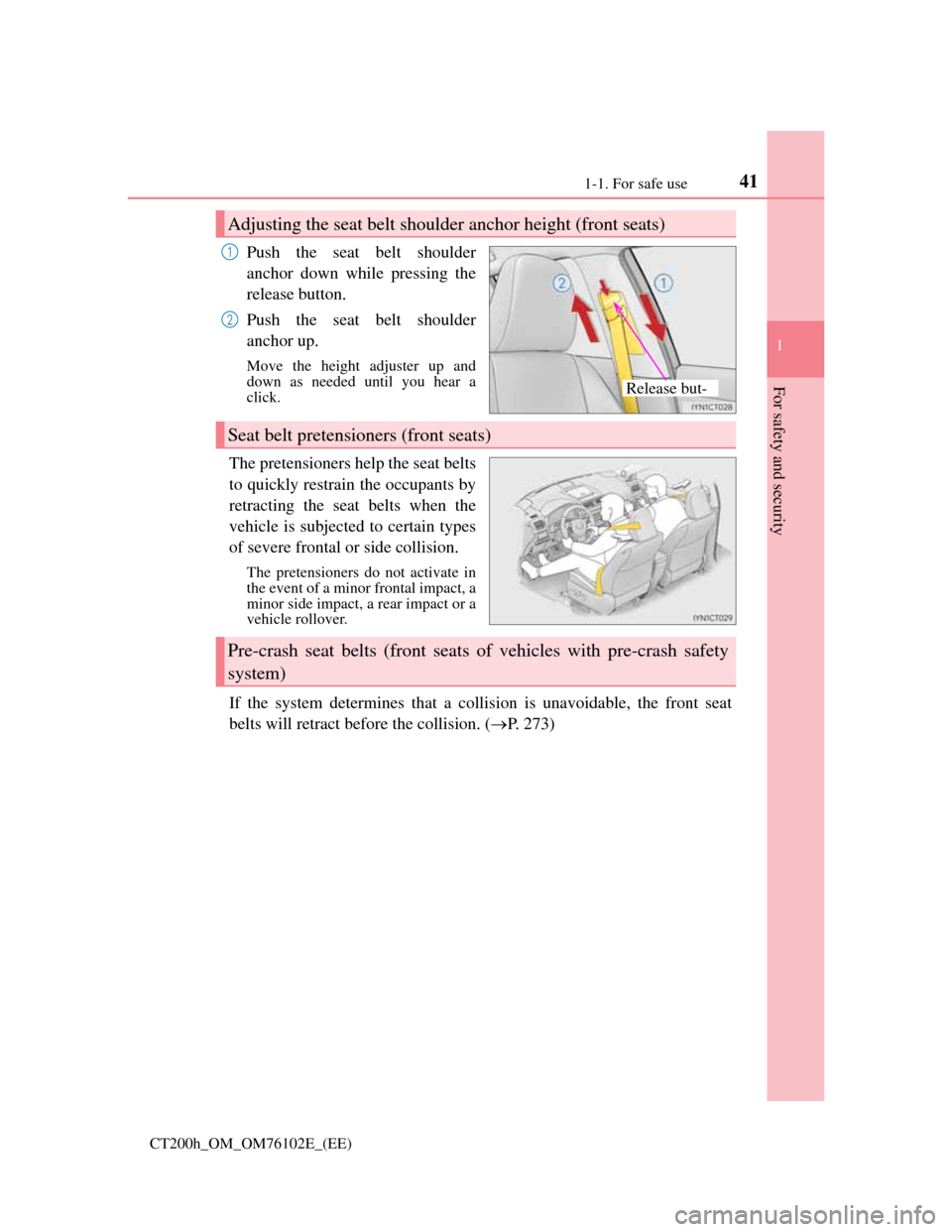
411-1. For safe use
1
CT200h_OM_OM76102E_(EE)
For safety and security
Push the seat belt shoulder
anchor down while pressing the
release button.
Push the seat belt shoulder
anchor up.
Move the height adjuster up and
down as needed until you hear a
click.
The pretensioners help the seat belts
to quickly restrain the occupants by
retracting the seat belts when the
vehicle is subjected to certain types
of severe frontal or side collision.
The pretensioners do not activate in
the event of a minor frontal impact, a
minor side impact, a rear impact or a
vehicle rollover.
If the system determines that a collision is unavoidable, the front seat
belts will retract before the collision. (P. 273)
Adjusting the seat belt shoulder anchor height (front seats)
Release but-
1
2
Seat belt pretensioners (front seats)
Pre-crash seat belts (front seats of vehicles with pre-crash safety
system)
Page 43 of 688
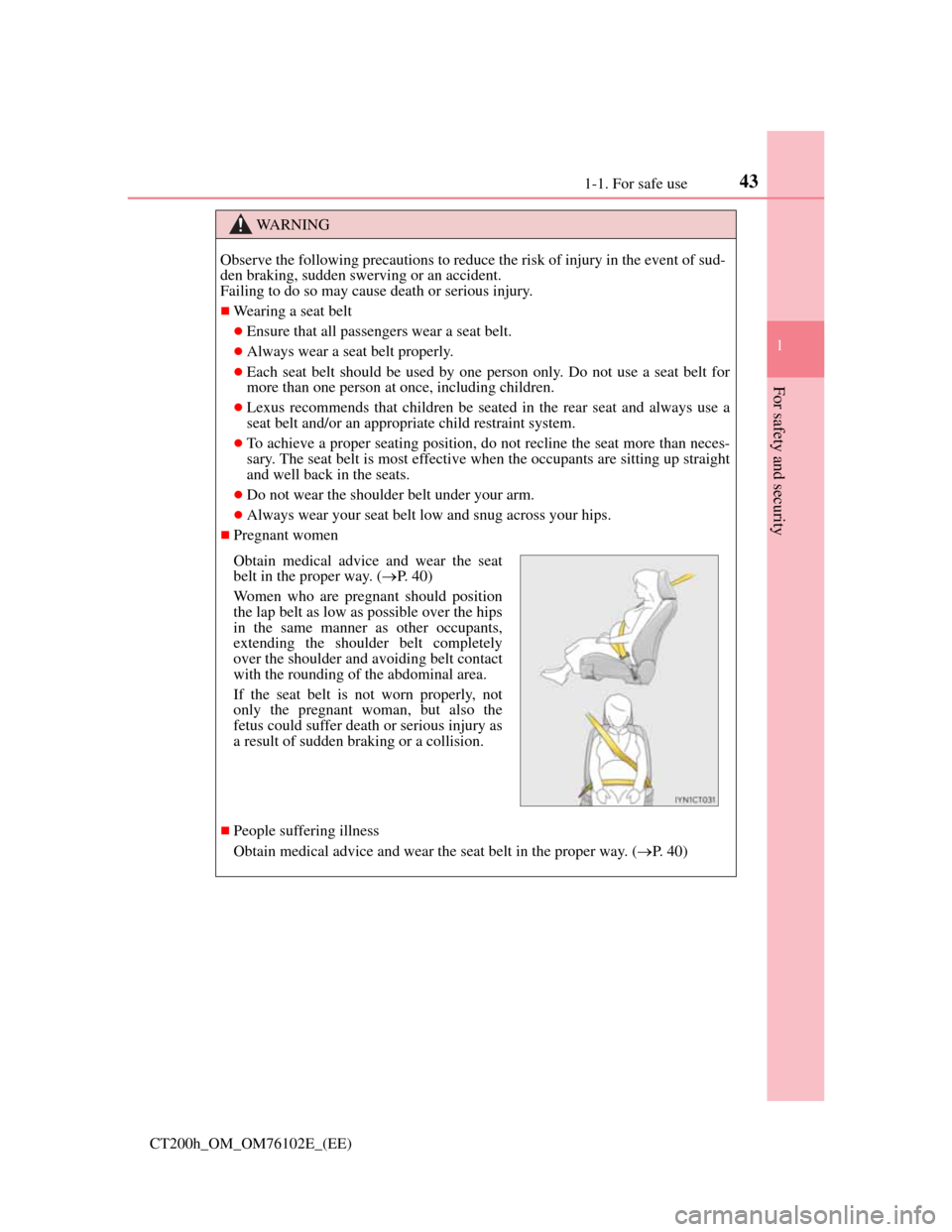
431-1. For safe use
1
CT200h_OM_OM76102E_(EE)
For safety and security
WA R N I N G
Observe the following precautions to reduce the risk of injury in the event of sud-
den braking, sudden swerving or an accident.
Failing to do so may cause death or serious injury.
Wearing a seat belt
Ensure that all passengers wear a seat belt.
Always wear a seat belt properly.
Each seat belt should be used by one person only. Do not use a seat belt for
more than one person at once, including children.
Lexus recommends that children be seated in the rear seat and always use a
seat belt and/or an appropriate child restraint system.
To achieve a proper seating position, do not recline the seat more than neces-
sary. The seat belt is most effective when the occupants are sitting up straight
and well back in the seats.
Do not wear the shoulder belt under your arm.
Always wear your seat belt low and snug across your hips.
Pregnant women
People suffering illness
Obtain medical advice and wear the seat belt in the proper way. (P. 40)
Obtain medical advice and wear the seat
belt in the proper way. (P. 40)
Women who are pregnant should position
the lap belt as low as possible over the hips
in the same manner as other occupants,
extending the shoulder belt completely
over the shoulder and avoiding belt contact
with the rounding of the abdominal area.
If the seat belt is not worn properly, not
only the pregnant woman, but also the
fetus could suffer death or serious injury as
a result of sudden braking or a collision.
Page 45 of 688
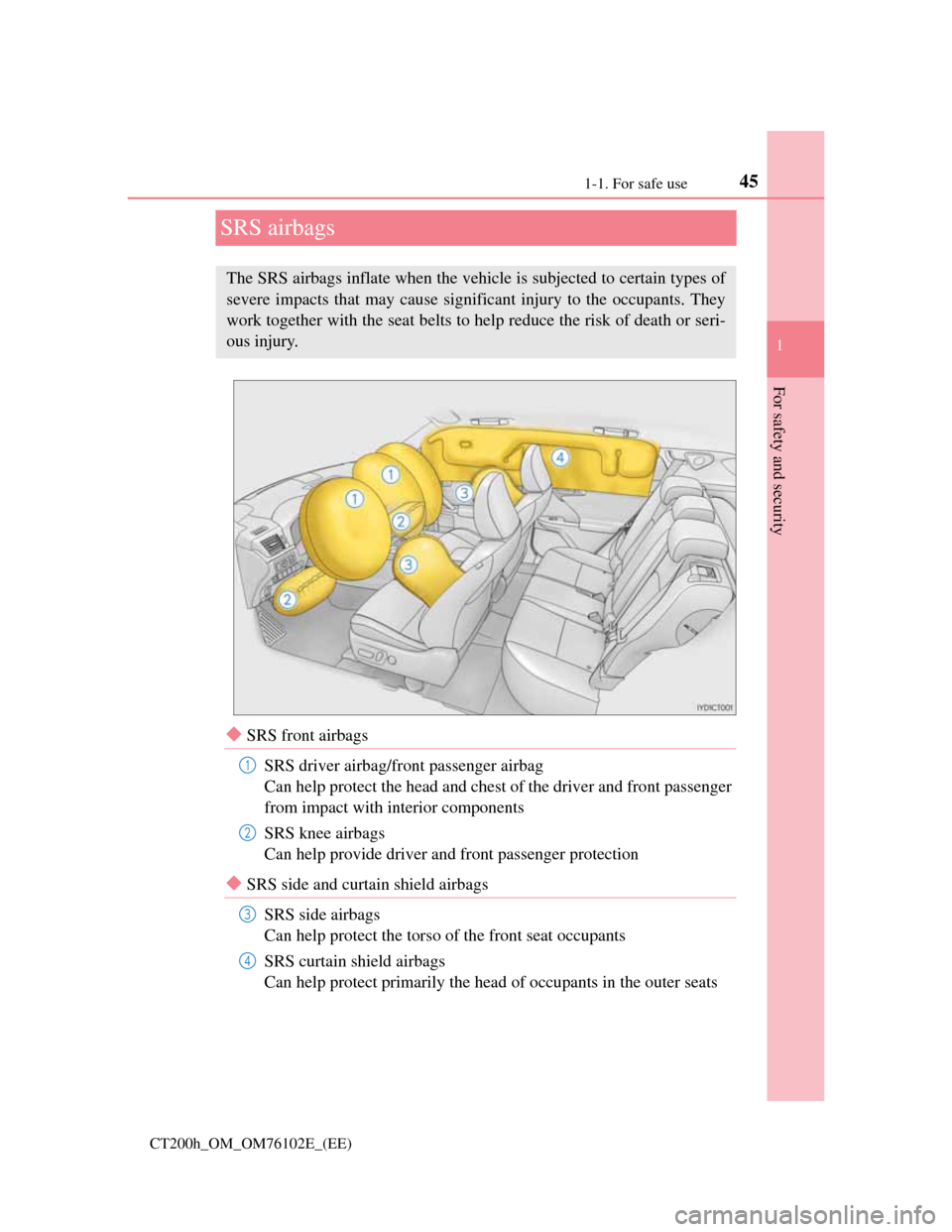
451-1. For safe use
1
For safety and security
CT200h_OM_OM76102E_(EE)
SRS airbags
SRS front airbags
SRS driver airbag/front passenger airbag
Can help protect the head and chest of the driver and front passenger
from impact with interior components
SRS knee airbags
Can help provide driver and front passenger protection
SRS side and curtain shield airbags
SRS side airbags
Can help protect the torso of the front seat occupants
SRS curtain shield airbags
Can help protect primarily the head of occupants in the outer seats
The SRS airbags inflate when the vehicle is subjected to certain types of
severe impacts that may cause significant injury to the occupants. They
work together with the seat belts to help reduce the risk of death or seri-
ous injury.
1
2
3
4
Page 47 of 688
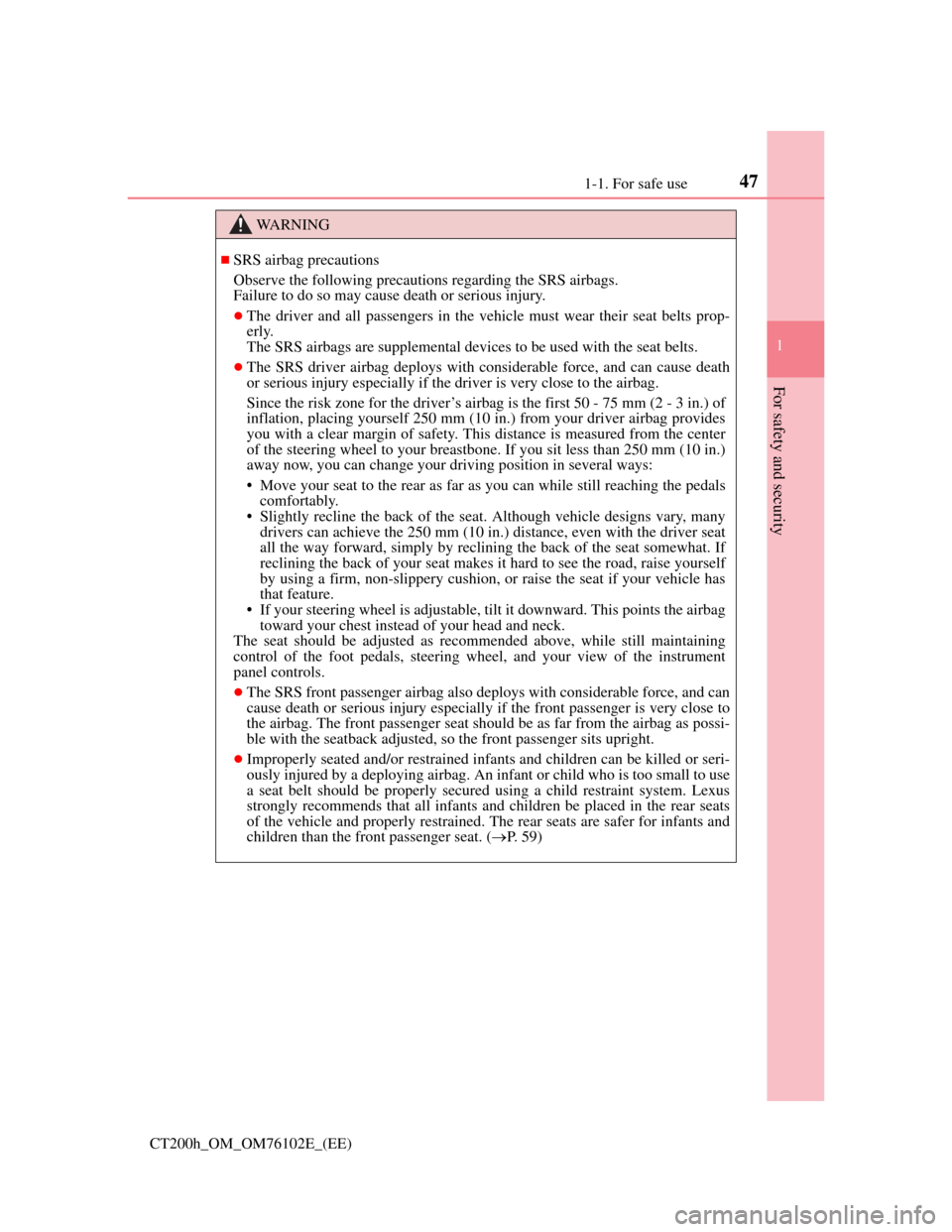
471-1. For safe use
1
CT200h_OM_OM76102E_(EE)
For safety and security
WA R N I N G
SRS airbag precautions
Observe the following precautions regarding the SRS airbags.
Failure to do so may cause death or serious injury.
The driver and all passengers in the vehicle must wear their seat belts prop-
erly.
The SRS airbags are supplemental devices to be used with the seat belts.
The SRS driver airbag deploys with considerable force, and can cause death
or serious injury especially if the driver is very close to the airbag.
Since the risk zone for the driver’s airbag is the first 50 - 75 mm (2 - 3 in.) of
inflation, placing yourself 250 mm (10 in.) from your driver airbag provides
you with a clear margin of safety. This distance is measured from the center
of the steering wheel to your breastbone. If you sit less than 250 mm (10 in.)
away now, you can change your driving position in several ways:
• Move your seat to the rear as far as you can while still reaching the pedals
comfortably.
• Slightly recline the back of the seat. Although vehicle designs vary, many
drivers can achieve the 250 mm (10 in.) distance, even with the driver seat
all the way forward, simply by reclining the back of the seat somewhat. If
reclining the back of your seat makes it hard to see the road, raise yourself
by using a firm, non-slippery cushion, or raise the seat if your vehicle has
that feature.
• If your steering wheel is adjustable, tilt it downward. This points the airbag
toward your chest instead of your head and neck.
The seat should be adjusted as recommended above, while still maintaining
control of the foot pedals, steering wheel, and your view of the instrument
panel controls.
The SRS front passenger airbag also deploys with considerable force, and can
cause death or serious injury especially if the front passenger is very close to
the airbag. The front passenger seat should be as far from the airbag as possi-
ble with the seatback adjusted, so the front passenger sits upright.
Improperly seated and/or restrained infants and children can be killed or seri-
ously injured by a deploying airbag. An infant or child who is too small to use
a seat belt should be properly secured using a child restraint system. Lexus
strongly recommends that all infants and children be placed in the rear seats
of the vehicle and properly restrained. The rear seats are safer for infants and
children than the front passenger seat. (P. 59)
Page 50 of 688

501-1. For safe use
CT200h_OM_OM76102E_(EE)
WA R N I N G
SRS airbag precautions
If breathing becomes difficult after the SRS airbags have deployed, open a
door or window to allow fresh air in, or leave the vehicle if it is safe to do so.
Wash off any residue as soon as possible to prevent skin irritation.
If the areas where the SRS airbags are stored, such as the steering wheel pad
and front and rear pillar garnishes, are damaged or cracked, have them
replaced by any authorized Lexus dealer or repairer, or another duly qualified
and equipped professional.
Modification and disposal of SRS airbag system components
Do not dispose of your vehicle or perform any of the following modifications
without consulting any authorized Lexus dealer or repairer, or another duly
qualified and equipped professional. The SRS airbags may malfunction or
deploy (inflate) accidentally, causing death or serious injury.
Installation, removal, disassembly and repair of the SRS airbags
Repairs, modifications, removal or replacement of the steering wheel, instru-
ment panel, dashboard, seats or seat upholstery, front, side and rear pillars or
roof side rails
Repairs or modifications of the front fender, front bumper, or side of the occu-
pant compartment
Installation of a grille guard (bull bars, kangaroo bar, etc.), snow plows or
winches
Modifications to the vehicle’s suspension system
Installation of electronic devices such as mobile two-way radios (RF-trans-
mitter) and CD players
Modifications to your vehicle for a person with a physical disability
Page 51 of 688
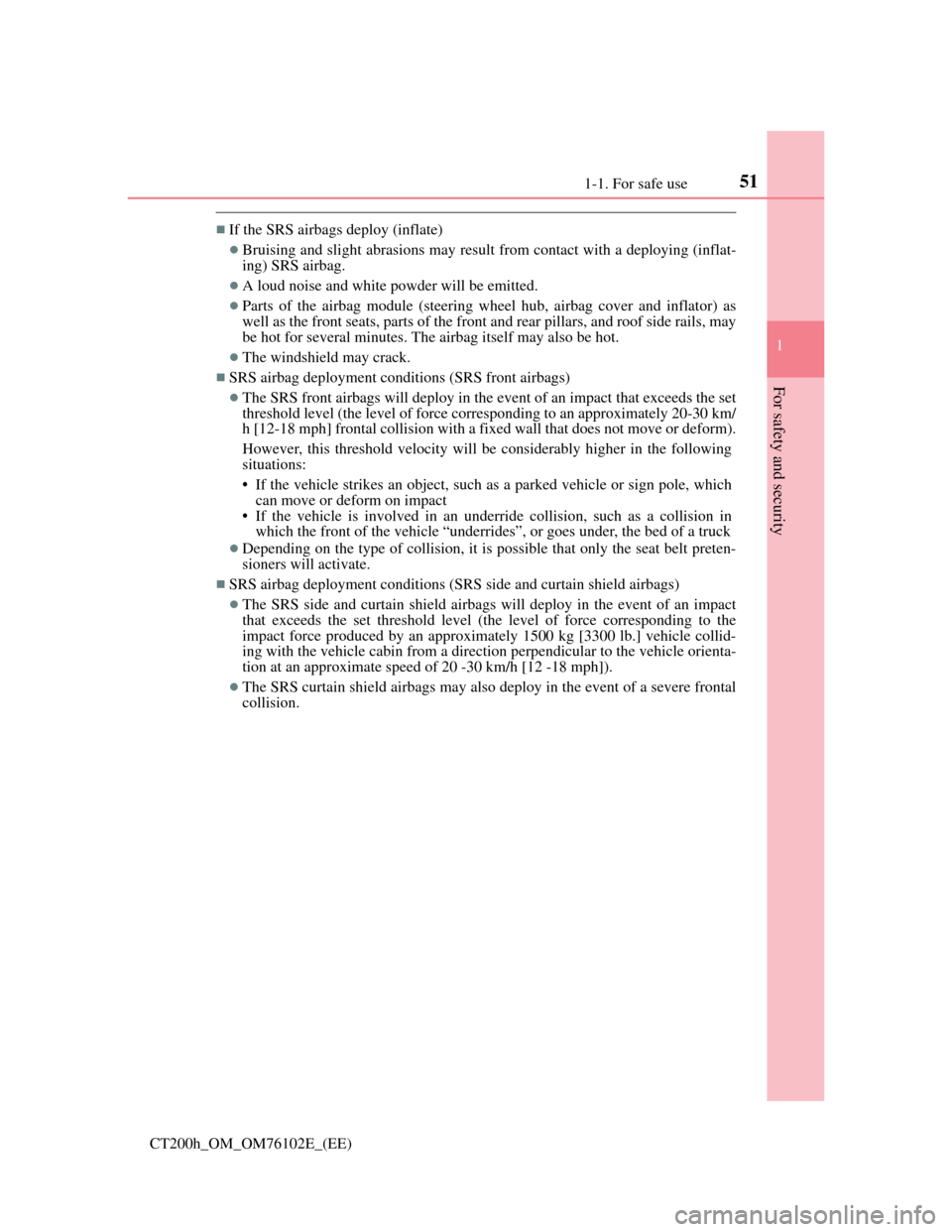
511-1. For safe use
1
CT200h_OM_OM76102E_(EE)
For safety and security
If the SRS airbags deploy (inflate)
Bruising and slight abrasions may result from contact with a deploying (inflat-
ing) SRS airbag.
A loud noise and white powder will be emitted.
Parts of the airbag module (steering wheel hub, airbag cover and inflator) as
well as the front seats, parts of the front and rear pillars, and roof side rails, may
be hot for several minutes. The airbag itself may also be hot.
The windshield may crack.
SRS airbag deployment conditions (SRS front airbags)
The SRS front airbags will deploy in the event of an impact that exceeds the set
threshold level (the level of force corresponding to an approximately 20-30 km/
h [12-18 mph] frontal collision with a fixed wall that does not move or deform).
However, this threshold velocity will be considerably higher in the following
situations:
• If the vehicle strikes an object, such as a parked vehicle or sign pole, which
can move or deform on impact
• If the vehicle is involved in an underride collision, such as a collision in
which the front of the vehicle “underrides”, or goes under, the bed of a truck
Depending on the type of collision, it is possible that only the seat belt preten-
sioners will activate.
SRS airbag deployment conditions (SRS side and curtain shield airbags)
The SRS side and curtain shield airbags will deploy in the event of an impact
that exceeds the set threshold level (the level of force corresponding to the
impact force produced by an approximately 1500 kg [3300 lb.] vehicle collid-
ing with the vehicle cabin from a direction perpendicular to the vehicle orienta-
tion at an approximate speed of 20 -30 km/h [12 -18 mph]).
The SRS curtain shield airbags may also deploy in the event of a severe frontal
collision.